In the Eye of the Storm: Modernism in Ukraine, 1900-1930s
The Royal Museum of Fine Arts of Belgium in Brussels is currently hosting an exhibition titled In the Eye of the Storm: Modernism in Ukraine,...
Tommy Thiange 2 November 2023
Mykola Pymonenko (1862-1912) was a Ukrainian realist painter. He spent almost his entire life in Kyiv and dedicated his career to painting genre scenes. Truly, his works are a window into the life and culture of the Ukrainian people in the 19th century. His talent led him to meet other artists such as Ilya Repin and Kazimir Malevich. Today, he is considered one of the most important artists of his country. During his lifetime he gained widespread recognition both nationally and internationally.
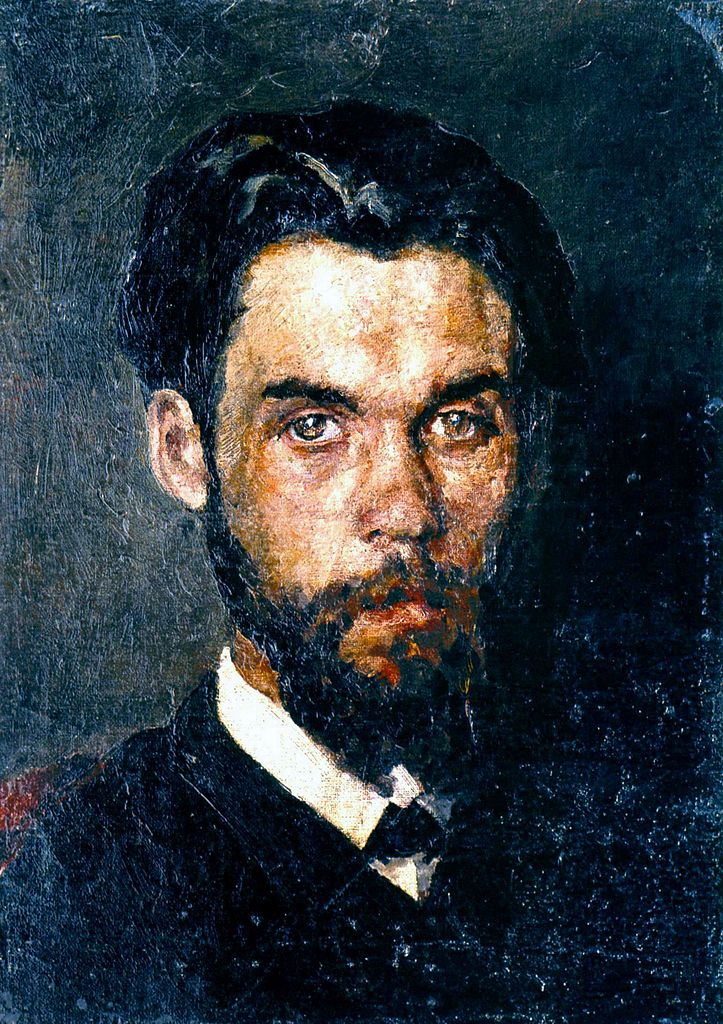
Mykola Pymonenko, Self-portrait, 1886, National Art Museum of Ukraine, Kyiv, Ukraine. Wikimedia Commons (public domain).
On March 9, 1862, Mykola Kornylovych Pymonenko was born in the village of Priorka, Kyiv. At the time, that territory was part of the Russian Empire. For this reason, he is often cataloged as a Russian painter, and unfortunately, he is not the only artist in this situation. Therefore, it is important to emphasize that he was Ukrainian.
He was the son of a woodcarver and an icon painter and often accompanied his father who made altars and paintings for churches. Most probably, this contact with the country led him to decide on a career in genre painting. Later, he began assisting at his workshop. And, in 1873, he entered the Kyiv Pechersk Lavra (Kyiv Monastery of the Caves) to study icon painting.
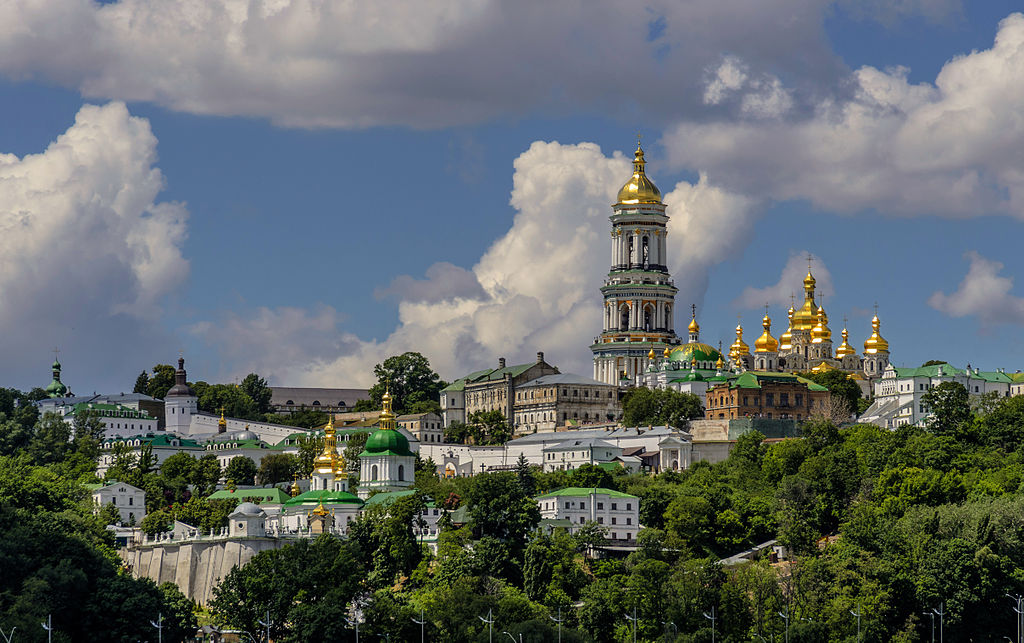
Photo by Falin, Kyiv-Pechersk Lavra Complex. Kyiv, Ukraine.Wikimedia Commons (public domain).
While his economic situation kept him from formal artistic education, his talent opened doors for him. Right away, in 1876, famous Ukrainian artist and art teacher Mykola Murashko noticed his works. Truly, he must have been very impressed with what he saw. Indeed, Murashko offered Pymonenko a place at his Drawing School in Kyiv. Luckily, he managed to waive his tuition and soon enough the young artist stood out as one of the best students.
Then, he briefly studied at the Russian Academy of Fine Arts in Saint Petersburg (1882–1884). Additionally, they allowed him to give classes at lower-secondary schools. Moreover, he received three silver medals for his accomplishments. Nevertheless, health problems and financial hardships forced him to go back to Kyiv.
During his career, Pymonenko made portraits of his family and close circle.
Back at home, he returned to the Mykola Murashko Drawing School. This time, he was the teacher. Sadly, the school had to close after a few years. As a result, in 1901, he went to work at the Kyiv Polytechnic Institute and gave drawing classes to engineers. Simultaneously, he was one of the founders and teachers of the Kyiv Art School. However, he never abandoned painting. For example, he became a part of The Peredvizhniki group which rejected the constraints of the Imperial Academy. Later, it became the Association of Traveling Exhibitions. An important place in the artist’s works is occupied by the lyrical and unique image of Ukraine, the charm of the native land with its cheerful people. For this, Mykola Pymonenko was called a “master of household painting”.
Meanwhile, Pymonenko also created historical paintings. For example, he focused on the motifs of the Cossacks – a historically famous self-governing and semi-military community, which existed on the territory of Ukraine. In fact, this group is still a national symbol for Ukrainians since the 15th century.
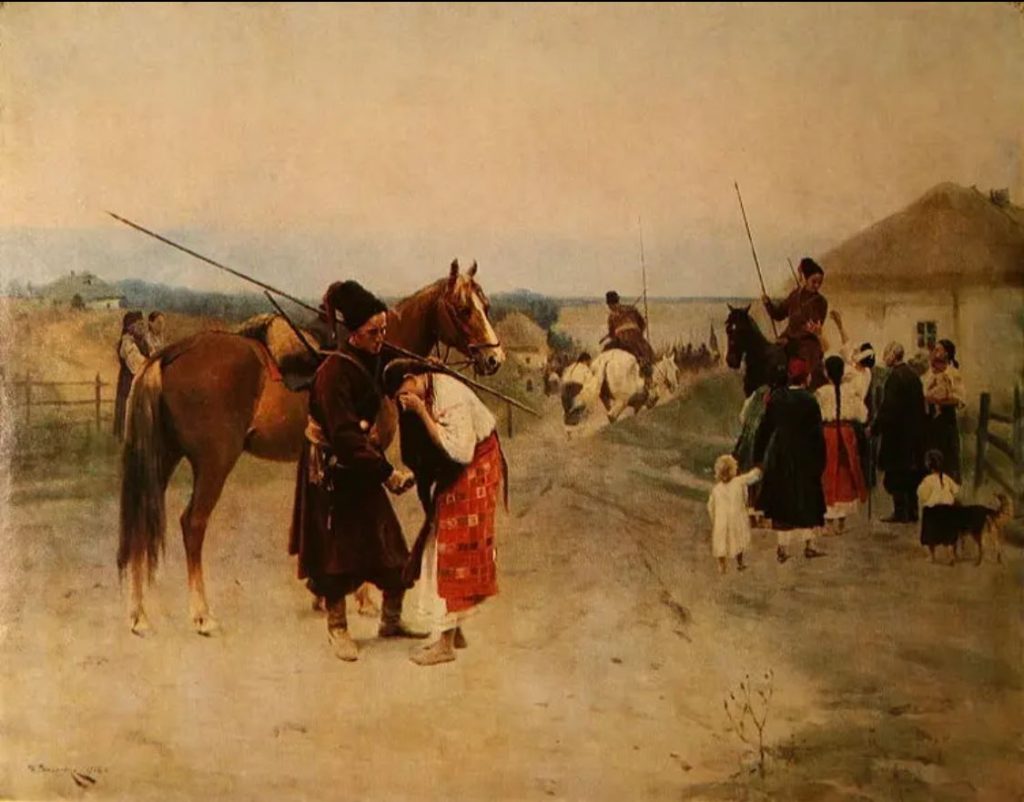
Mykola Pymonenko, Camping. Seeing the Cossacks, 1902, The National Art Museum of Ukraine, Kyiv, Ukraine. Wikimedia Commons (public domain).
Added to it, he also depicted social problems. For example, the canvas Victim of Fanaticism illustrates a tragic moment in the town of Kremenetz in the Volyn region. Here, a young Jewish woman is cornered by an angry mob. Simply, her crime was being in a relationship with a Ukrainian man for whom she converted to Christianity. Interestingly, Pymonenko was Christian Orthodox. Nonetheless, the Jewish community accepted his work. Contrary to other works, this represented their struggles in the Russian Empire. In fact, having a critical stand was part of the artist’s principles.
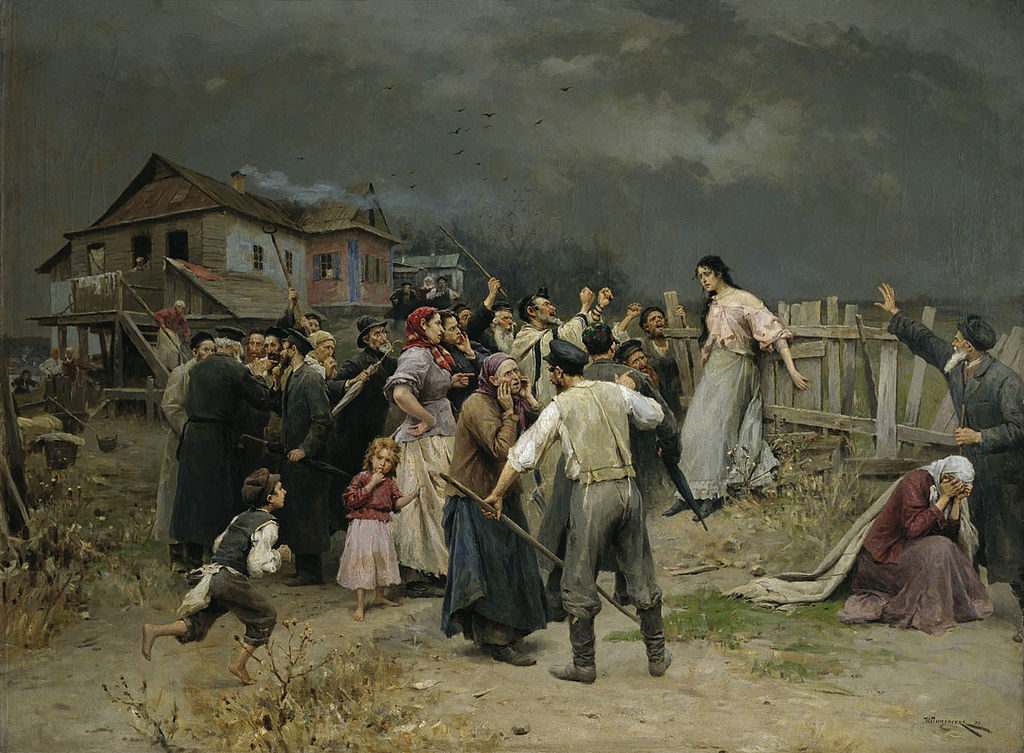
Mykola Pymonenko, Victim of Fanaticism, 1899, Fine Arts Museum, Kharkiv, Ukraine. Wikimedia Commons (public domain).
Later on, he participated in painting the interiors of the Volodymyr Cathedral. Certainly, it was a bit of a return to his beginnings as an icon painter, as well as his father’s profession. Specifically, he painted the images of Saint Anne and Nicholas of Myra. Additionally, he made some images on the pediment. Consequently, he received the Order of St. Anne III degree in 1897.
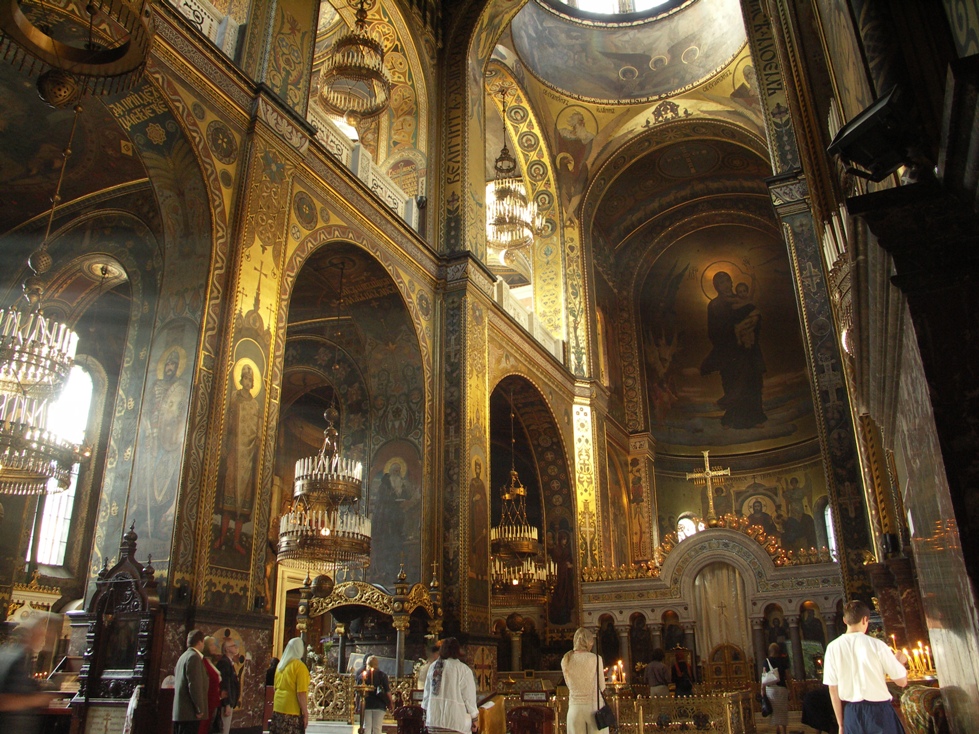
Photo by Robert Broadie, Interior of St Volodymyr’s Cathedral in Kyiv. Wikipedia Commons (public domain).
Besides, in 1909, he made it into one of the most prestigious exhibitions in Europe. Indeed, the Paris Salon accepted his painting Hopak, titled after a traditional Ukrainian folk dance. Furthermore, he received a gold medal from the Society of French Artists. In fact, the Louvre quickly acquired the canvas. Moreover, he exhibited in London, Berlin, and Rome. Equally important, he joined several organizations in those cities.
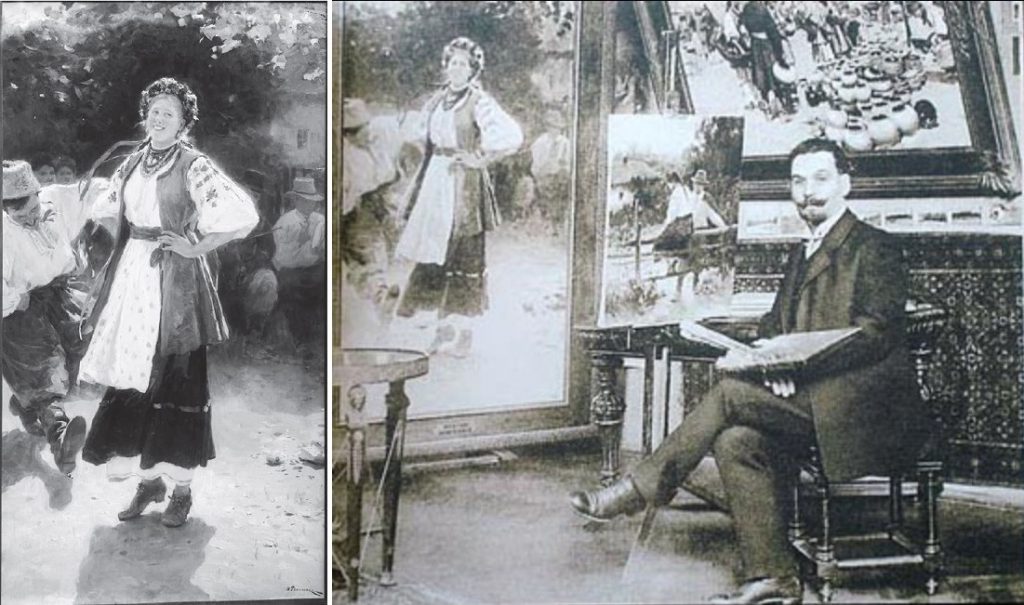
Left: Mykola Pymonenko, Hopak, 1909. Photo by Francois Antoine Vizzavona. Right: M. Pymonenko in his studio next to the picture Hopak, c. 1909, Wikimedia Commons (public domain).
In fact, one of his students, Kazimir Malevich saw the painting during one of his visits to Pymonenko’s studio.
There were a great many easels with paintings depicting life in Ukraine.
Autobiography. Cited in Jean-Claude Marcadé’s Kyiv: The Capital of Modernity at the Turn of the Twentieth Century, 2019.
Now, one of his most notable students was Malevich. Of course, he adopted a very different style. Nevertheless, there are a few paintings that clearly reveal Pymonenko’s influence. For instance, as Jean-Claude Marcadé notices, the poses of Floor Polishers are similar to those of Hopak. Likewise, he depicted peasants. Aside from him, he taught many of the later avant-garde painters such as Sergei Kostenko, Olexander Murashko, and even Lesya Ukrainka.
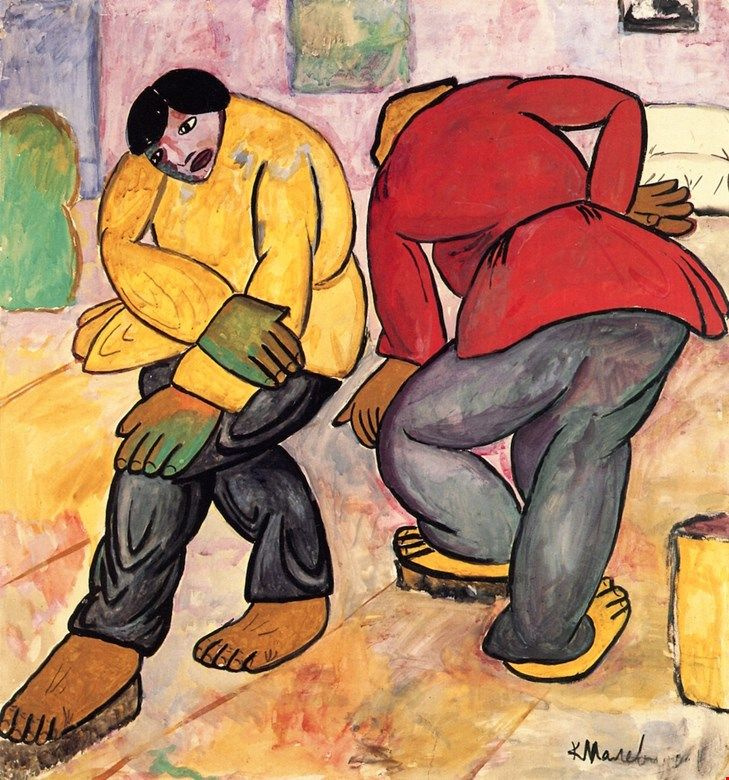
Kazimir Malevich, Floor Polishers, 1911, Collection Stedelijk Museum Amsterdam, Amsterdam, Netherlands. Gallerix.
Unfortunately, his health problems continued, and in 1912, Pymonenko died and was buried in the Lukyanivka Cemetery. Although his life was short, the legacy he left was huge. Aside from his paintings, there are illustrations for Taras Shevchenko’s poems. Moreover, the year after his death, the Academy of Arts organized an exhibition featuring hundreds of his works, from oil paintings to sketches and drawings.
Finally, in 2012, the National Art Museum of Ukraine commemorated the 150th anniversary of his birth with an exhibition and there is the Pymonenko Museum in Malyutyanka, Kyiv.
Pymonenko is dead. What a loss for the Itinerants! He was a true Ukrainian; will not be forgotten by the country for his truthful and lovely, like Ukraine, paintings, (…)
Museum of Ukrainian Paintings, Dniper. Museum’s website.
Kotlyar, Eugeny, “Painting “Victim of Fanaticism” by Mykola Pymonenko in the Context of Jewish Art and the “Jewish Question” in the Russian Empire”, Judaica Ukrainica 2 (2013): 126–141. Accessed on 8 March 2022.
Marcadé, Jean-Claude, “Kyiv: The Capital of Modernity at the Turn Ofthe Twentieth Century.” Harvard Ukrainian Studies 36, no. 3/4 (2019): 275–306. Accessed on 7 March 2022.
“Mykola Pymonenko: Biographical sketch”. Ukrainian art library, 2016. Accessed on 6 March 2022.
“Nikolay Kornilevich Pimonenko”. Arthive. Accessed on 6 March 2022.
“Pimonenko Mikola Kornilievich. On the 150th anniversary of his birth”. The National Technical University of Ukraine. Accessed on 6 March 2022.
“PIMONENKO Nikolai Kornilovich”. Museum of Ukrainian Paintings, Dnipro. Accessed on 7 March 2022.
DailyArt Magazine needs your support. Every contribution, however big or small, is very valuable for our future. Thanks to it, we will be able to sustain and grow the Magazine. Thank you for your help!